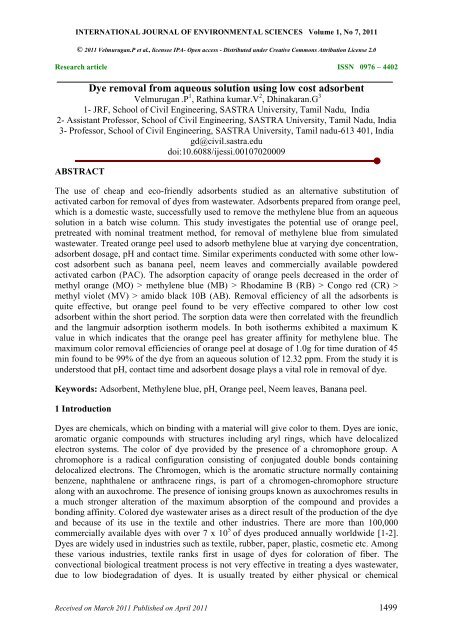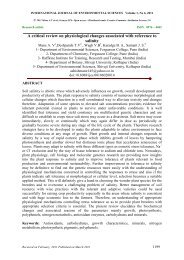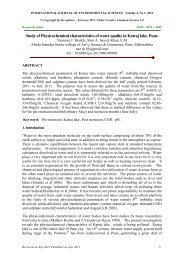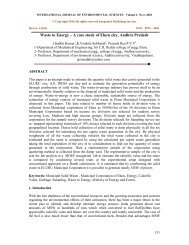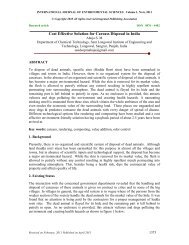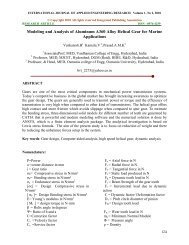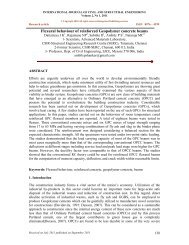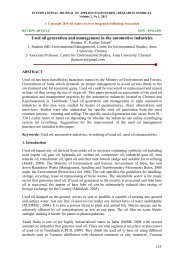Full text pdf
Full text pdf
Full text pdf
Create successful ePaper yourself
Turn your PDF publications into a flip-book with our unique Google optimized e-Paper software.
INTERNATIONAL JOURNAL OF ENVIRONMENTAL SCIENCES Volume 1, No 7, 2011<br />
© 2011 Velmurugan.P et al., licensee IPA- Open access - Distributed under Creative Commons Attribution License 2.0<br />
Research article ISSN 0976 – 4402<br />
Dye removal from aqueous solution using low cost adsorbent<br />
Velmurugan .P 1 , Rathina kumar.V 2 , Dhinakaran.G 3<br />
1- JRF, School of Civil Engineering, SASTRA University, Tamil Nadu, India<br />
2- Assistant Professor, School of Civil Engineering, SASTRA University, Tamil Nadu, India<br />
3- Professor, School of Civil Engineering, SASTRA University, Tamil nadu-613 401, India<br />
gd@civil.sastra.edu<br />
doi:10.6088/ijessi.00107020009<br />
ABSTRACT<br />
The use of cheap and eco-friendly adsorbents studied as an alternative substitution of<br />
activated carbon for removal of dyes from wastewater. Adsorbents prepared from orange peel,<br />
which is a domestic waste, successfully used to remove the methylene blue from an aqueous<br />
solution in a batch wise column. This study investigates the potential use of orange peel,<br />
pretreated with nominal treatment method, for removal of methylene blue from simulated<br />
wastewater. Treated orange peel used to adsorb methylene blue at varying dye concentration,<br />
adsorbent dosage, pH and contact time. Similar experiments conducted with some other lowcost<br />
adsorbent such as banana peel, neem leaves and commercially available powdered<br />
activated carbon (PAC). The adsorption capacity of orange peels decreased in the order of<br />
methyl orange (MO) > methylene blue (MB) > Rhodamine B (RB) > Congo red (CR) ><br />
methyl violet (MV) > amido black 10B (AB). Removal efficiency of all the adsorbents is<br />
quite effective, but orange peel found to be very effective compared to other low cost<br />
adsorbent within the short period. The sorption data were then correlated with the freundlich<br />
and the langmuir adsorption isotherm models. In both isotherms exhibited a maximum K<br />
value in which indicates that the orange peel has greater affinity for methylene blue. The<br />
maximum color removal efficiencies of orange peel at dosage of 1.0g for time duration of 45<br />
min found to be 99% of the dye from an aqueous solution of 12.32 ppm. From the study it is<br />
understood that pH, contact time and adsorbent dosage plays a vital role in removal of dye.<br />
Keywords: Adsorbent, Methylene blue, pH, Orange peel, Neem leaves, Banana peel.<br />
1 Introduction<br />
Dyes are chemicals, which on binding with a material will give color to them. Dyes are ionic,<br />
aromatic organic compounds with structures including aryl rings, which have delocalized<br />
electron systems. The color of dye provided by the presence of a chromophore group. A<br />
chromophore is a radical configuration consisting of conjugated double bonds containing<br />
delocalized electrons. The Chromogen, which is the aromatic structure normally containing<br />
benzene, naphthalene or anthracene rings, is part of a chromogen-chromophore structure<br />
along with an auxochrome. The presence of ionising groups known as auxochromes results in<br />
a much stronger alteration of the maximum absorption of the compound and provides a<br />
bonding affinity. Colored dye wastewater arises as a direct result of the production of the dye<br />
and because of its use in the <strong>text</strong>ile and other industries. There are more than 100,000<br />
commercially available dyes with over 7 x 10 5 of dyes produced annually worldwide [1-2].<br />
Dyes are widely used in industries such as <strong>text</strong>ile, rubber, paper, plastic, cosmetic etc. Among<br />
these various industries, <strong>text</strong>ile ranks first in usage of dyes for coloration of fiber. The<br />
convectional biological treatment process is not very effective in treating a dyes wastewater,<br />
due to low biodegradation of dyes. It is usually treated by either physical or chemical<br />
Received on March 2011 Published on April 2011 1499
Dye removal from aqueous solution using low cost adsorbent<br />
processes. However, these processes were very expensive and could not be effectively used<br />
to treat the wide range of dyes waste [Grag et al, 2003].<br />
The adsorption process is one of the effective methods for removal dyes from the waste<br />
effluent. The process of adsorption has an edge over the other methods due to its sludge free<br />
clean operation and completely removed dyes, even from the diluted solution. Activated<br />
carbon (powdered or granular) is the most widely used adsorbents because it has excellent<br />
adsorption efficiency for the organic compound. Nevertheless, commercially available<br />
activated carbon is very expensive. Furthermore, regeneration using solution produced small<br />
additional effluent while regeneration by refractory technique results in a 10-15% loss of<br />
adsorbents and its uptake capacity [Shaobin Wang et al, 2005]. The sorption data have been<br />
correlated with adsorption isotherm to determine the efficiency of adsorption process.<br />
Numerous researchers worked earlier on variety of adsorpents as mentioned below. Wool<br />
Fiber and Cotton Fiber [Rasheed Khan et al, 2005], Banana pith [Namasivayam et al,<br />
1993a,1993b], Biogas residual slurry [Namasivayam et al, 1992a], Carbonized coir pith<br />
[Namasivayam et al, 2001a], Coir pith [Namasivayam et al, 2001b,2002], Chitosan [Juang et<br />
al, 1996], Hardwood [Asfour et al, 1985], Mahogany sawdust, rice husk [Namasivayam et<br />
al,1992b], Parthenium hysterophorus [Rajeshwarisivaraj et al, 2002], Neem (Azadirachta<br />
Indica) husk [Alau et al, 2010], Rice husk [Singh et al, 2001], Rice husk [Guo et al, 2003],<br />
Silk cotton hull, coconut tree sawdust [Kadirvelu et al, 2003], Gypsum [Muhammad Rauf et<br />
al, 2009], Tuberose Sticks [Ahsan habib et al, 2006], Tamarind Fruit Shell[Papita Saha 2010].<br />
2 Experimental Investigations<br />
2.1 Preparation of the Adsorbent<br />
Adsorbents like Orange Peel, Neem leaves and Banana peel collected from the local areas of<br />
Thanjavur District. The peels and leaves collected and dried at low temperature (
Dye removal from aqueous solution using low cost adsorbent<br />
Table 2: Physical Properties of Adsorbents<br />
No. Parameter Value<br />
Orange Peel Neem Banana Activeted<br />
Leaves Peel Carbon<br />
01. Moisture Content (%) 38.50 11.10 7.70 30.00<br />
02. Ash Content (%) 17.80 4.30 5.60 30.00<br />
03. Volatile Content (%) 43.70 84.60 86.70 40.00<br />
04. Specific Gravity 3.22 2.85 3.13 1.83<br />
05. Fineness Modulus 3.24 3.128 3.02 2.17<br />
06. Particle size (mm) 0.150 0.186 0.200 0.002<br />
07. Void ratio 0.75 0.75 0.36 0.50<br />
08. Particle Density (g/cc) 1.44 0.56 0.92 1.90<br />
2.3 Calibration of Methylene Blue<br />
The synthetic dye sample calibrated in order to find out various optical densities at various<br />
concentrations. The calibrated results are very effective to identify the respective color<br />
removal capacities of various adsorbents Figure1 showing the graphical representation of<br />
Calibration of Methylene Blue.<br />
Figure 1: Calibration of Methylene Blue.<br />
Velmurugan. P, Rathina kumar. V, Dhinakaran. G<br />
International Journal of Environmental Sciences Volume 1 No.7, 2011<br />
1501
Dye removal from aqueous solution using low cost adsorbent<br />
2.4 Effect of time on various adsorbents<br />
In each adsorption experiment, 20 ml of dye solution of known concentration and pH was<br />
added to 0.1g of adsorbents in 250 ml round bottom flask at room temperature and the<br />
mixture was stirred on a rotary orbital shaker at 150 rpm. The sample withdrawn from the<br />
shaker at the pre determined time intervals for 10 minutes each. At the end of 10 min, the<br />
agitated sample taken from the shaker and tested for its optical density using the UV-Visible<br />
Spectrophotometer. The corresponding Optical Density interpolated with the initial<br />
calibration values in order to find out color removal efficiency of the adsorbent. From the<br />
Comparative results, it is clearly known that, the effect of duration plays a very important<br />
role in adsorption process of color removal. All the adsorbents are quite effective, but Orange<br />
peel found to be very effective next to activated Carbon. The color removal efficiencies of the<br />
adsorbents have a break through at 60 minutes duration, in which there is no further color<br />
removal takes place. Orange Peel found to be very effective with color removing efficiency<br />
of 96%. The results of present study are compared with results of Papita Saha 2010, who has<br />
done experiments with Tamarind shell. It is inferred from the comparison that, upto the<br />
duration of 40 min, orange peel showed lesser efficiency and after 40 min it shows higher<br />
efficiency than the Tamarind shell. The comparative results of efficiency of various adsorbent<br />
with respect to time given in Figure 2. However, activated carbon performs well when<br />
compared to all these low cost adsorbents.<br />
Figure 2: Comparative results of various adsorbents on to Effect of Time<br />
2.5 Effect of adsorbent dosage on various adsorbents<br />
20 ml of the stock solution of 1000 ppm taken and with varied amount (0.2, 0.4, 0.6, 0.8, 1 g)<br />
of adsorbent fed into the 250ml round bottom flask and kept for agitation at 150 rpm using<br />
rotary orbital shakers for the regular interval of 45 minutes. At the end, the agitated sample<br />
taken from the shaker and tested for its optical density using the UV-Visible<br />
Spectrophotometer. The corresponding Optical Density interpolated with the initial<br />
calibration values in order to find out color removal efficiency of the adsorbent. From the<br />
Comparative results, it is clearly understood that the Effect of Adsorbent Dosage is also plays<br />
a very vital role in adsorption process for color removal. Among the three adsorbents, Orange<br />
Velmurugan. P, Rathina kumar. V, Dhinakaran. G<br />
International Journal of Environmental Sciences Volume 1 No.7, 2011<br />
1502
Dye removal from aqueous solution using low cost adsorbent<br />
peel found to be very effective next to Activated Carbon. Therefore, from the two parameters<br />
such as Effect of Time and Effect of Adsorbent dosage, Orange peel found to be an excellent<br />
adsorbent compared to Neem leaves and Banana Peel. The maximum color removal<br />
efficiencies of Orange peel, Neem leaves and Banana Peel at dosage of 1 g for a time<br />
duration of 45 minutes is found to be 98.76, 97.77 and 97.93 respectively Figure 3 Showing<br />
the graphical representation of comparative results various adsorbent with respect to<br />
adsorbent dosage.<br />
Figure 3: Comparative results of various Adsorbents on to Effect of Adsorbent Dosage<br />
2.6 Effect of pH on Orange Peel for Color Removal<br />
In Order to find the effect of pH, series of experiments conducted at various pH values from<br />
2-4 and 8-10 in acidic and alkaline conditions respectively. However, the initial pH of the<br />
stock solution prepared was 6.50 at 1000 ppm. The value of pH controlled by addition of<br />
sodium hydroxide or hydrochloric acid. For the present research, the stock solution of 20 ml<br />
taken and 0.1 g of adsorbent fed into round bottom flask and kept for rotary orbital shaker at<br />
150 rpm. The sample withdrawn from the shaker at the pre determined time intervals for 10<br />
minutes each. At the end of each 10 minutes the agitated sample is taken from the shaker and<br />
tested for its optical density using the UV-Visible Spectrophotometer.<br />
Effect of pH under acidic condition imparts a new color (greenish yellow) in which the<br />
respective optical density found to be more than 4.00, because of some acidic elements<br />
already present in the orange peel. Again some sample was analyzed at the pH of 4, the value<br />
of the optical density is slightly above the calibration value of the Methylene blue. Hence<br />
color removal under acidic condition using orange peel as an adsorbent found to be<br />
insignificant, where as for alkaline condition it is significant. Effect of pH and different<br />
dosage of adsorbent under alkaline conditions are depicted in Figures 4 and 5.<br />
Velmurugan. P, Rathina kumar. V, Dhinakaran. G<br />
International Journal of Environmental Sciences Volume 1 No.7, 2011<br />
1503
Dye removal from aqueous solution using low cost adsorbent<br />
Figure 4: Effect of pH under alkaline conditions at regular time interval.<br />
Figure 5: Effect of pH under alkaline conditions at various adsorbent dosages<br />
2.7 Column Study using Orange peel<br />
The column tests carried out in a micro-glass column with inside diameter of 12.5 mm,<br />
length 750 mm with a capacity of 50 ml. By using column study burette found to be very<br />
economical and there is no external driven force applied to the system. Series of burettes<br />
operated in a parallel way and filled with 10 ml of adsorbent and 40 ml of adsorbate. A thin<br />
layer of very fine particles of sand of diameter of 0.7 mm with the depth of 50 mm placed at<br />
the bottom in order to remove the foreign and dust particles. Figure 6 shows experimental<br />
setup of column study.<br />
Particle size plays a foremost role in adsorption process especially in the column studies and<br />
the particle size of the adsorbent is 0.6 mm. The effluent of the first column considered as the<br />
influent of the second column with time interval of 60 minutes each. The results are shown in<br />
Figure 7.<br />
The effluent from the each burette was taken and measured for its optical density. In order to<br />
correct for any adsorption of color by the container, control experiments carried out without<br />
adsorbents. It was found that there was no adsorption by the container walls. Similarly same<br />
test were carried out by using the filling material and was found that no adsorption took place,<br />
and the entire column tests conducted at room temperature only.<br />
Velmurugan. P, Rathina kumar. V, Dhinakaran. G<br />
International Journal of Environmental Sciences Volume 1 No.7, 2011<br />
1504
Dye removal from aqueous solution using low cost adsorbent<br />
Figure 6: Series of column tests conducted using burettes<br />
Figure 7: Efficiency of color removal using orange peel as adsorbent<br />
3 RESULTS AND DISCUSSIONS<br />
The study of isotherm data is important to find out the adsorption capacity of various<br />
adsorbents. In order to investigate the adsorption isotherm, two equilibrium isotherms were<br />
analyzed: Langmuir and Freundlich isotherms are used for fitting the experimental data in<br />
adsorption studies to understand the extent and degree of favorability of adsorption.<br />
3.1 Freundlich Isotherm<br />
The equilibrium adsorption isotherms are of fundamental importance in the design of<br />
adsorption systems. The equilibrium adsorption data could be satisfactory by the Freudlich<br />
isotherm<br />
x/m = K.C 1/n<br />
where x is the amount adsorbed per mass of adsorbent (m), Co is the initial concentration of<br />
the solution (ppm), C is the equilibrium concentration (ppm), and K and n are Freudlich<br />
Velmurugan. P, Rathina kumar. V, Dhinakaran. G<br />
International Journal of Environmental Sciences Volume 1 No.7, 2011<br />
1505
Dye removal from aqueous solution using low cost adsorbent<br />
constants. The constant K, partition coefficient in equilibrium is positively related to the<br />
extent of degree of adsorption, while then constant „n‟ provides a rough estimation of the<br />
intensity of adsorption. A linear form of the Freundlich expression will yield the constants K<br />
and n hence:<br />
log x/m = log K+1/n log C<br />
The analysis and design of adsorption separation process require the relevant adsorption<br />
equilibrium, which is the most important piece of information in understanding the<br />
adsorption process. The adsorption isotherms are equilibrium equation and apply to<br />
condition resulting after the adsorbate-containing phase has seen in contact with the<br />
adsorbent of sufficient time to reach equilibrium [Tan et al, 2010]. The adsorption capacity of<br />
any adsorbent may be determined by the used of an adsorption isotherm. Knowledge of<br />
adsorption capacity of an adsorbent material such as lignite enables the designer to develop<br />
treatment systems for particular adsorbate/adsorbent systems [Allen et al, 1989].<br />
Freudlich constants were determined from the graphs plotted for log (X/M) in ordinate and<br />
log Ce in abscissa. Table 3 shows the Orange peel has the maximum K value followed by<br />
Banana Peel and Neem leaves. The higher value of K (0.775mg/g) indicates that Orange Peel<br />
have greater affinity for methylene blue compared with other adsorbents. The adsorption<br />
intention „n‟ is found to 1.50, 0.612 and 1.273 for Orange peel, Neem leaves and Banana peel<br />
respectively. It is observed that all the adsorbents do not satisfy the condition of<br />
heterogeneity, i.e., 1
Dye removal from aqueous solution using low cost adsorbent<br />
per unit weight of adsorbent in forming a complete monolayer on the surface and k is the<br />
constant related to the energy. By plotting Ce versus Ce/Qe, a curve is obtained which is<br />
linear at low equilibrium concentrations, followed by a curvature and with an asymptotic<br />
tendency to saturation corresponding to a monolayer covering.<br />
Table 4: Langmuir Constants for various adsorbents<br />
Sl.No Name of the a (l/mg) K (l/g) R 2<br />
Adsorbent<br />
1. Orange Peel 0.00502 10,000 0.08368<br />
2. Neem leaves -0.00903 -3,333.33 0.5529<br />
3. Banana Peel 0.00411 10,000 0.0769<br />
4. Activated Carbon -0.00370 -33,333.33 0.0402<br />
From the Table 4 , the higher value of K (10,000) indicates that the amount of methylene<br />
blue per unit weight of adsorbent seem to significantly higher than Neem leaves, in which<br />
both orange peel and Banana peel have same values. Neem leaves is found to very non-linear,<br />
this will normally occur after dye particles fill the available monolayer in the adsorbents.<br />
This non-linearity may also be due to any primary expansion of adsorbent while will give<br />
way to a secondary or tertiary expansion which can occur at much reduced rates. From the<br />
results the higher value of K from Orange peel is found to be very effective followed by<br />
Banana peel and Neem leaves, which confirmes the result obtained from the Freudlich<br />
Isotherm that Orange peel has the maximum K value followed by Banana peel and Neem<br />
leaves. The plots showing results between log(X/M) and log (Ce) is given in Figure 8 for<br />
Freundlich Isotherm and between Ce/Qe and Ce is given in Figure 9 for Langmuir Isotherm.<br />
Figure 8: Freudlich Isotherm using Orange Peel<br />
Velmurugan. P, Rathina kumar. V, Dhinakaran. G<br />
International Journal of Environmental Sciences Volume 1 No.7, 2011<br />
1507
Dye removal from aqueous solution using low cost adsorbent<br />
Figure 9: Langmuir Isotherm using Orange Peel<br />
4 Conclusions<br />
From the results of the present study, it is concluded that, the adsorption process is a very<br />
effective process for the decolorization of <strong>text</strong>ile wastewater, as we can reach 97%<br />
decolorization in few minutes. There is a need to enhance the adsorption process effectively<br />
by varying parameters so as to bring down the values to permissible limits for wastewater<br />
before discharging it to the water environment. The removal of color from aqueous solutions<br />
and wastewaters using activated carbon and three low cost sorbent materials orange peel,<br />
neem leaves and banana peel was studied by studying the effect of time, adsorbent dosage<br />
and pH. A separate column study was conducted in which, flow was due to gravity. Two<br />
types of isotherms were investigated, namely the Langmuir and Freundlich isotherms.<br />
The adsorption studies revealed that the optimum time adsorption of Orange Peel, Neem<br />
leaves and Banana peel was found to be 60 minutes and adsorbent dosage was 1 g for all the<br />
three adsorbents. The isotherm analysis revealed that orange peel prepared under nominal<br />
treatment was found to be very effective than the Neem leaves and Banana Peel. Adsorption<br />
was an effective process for decolorization of <strong>text</strong>ile wastewaters. Although activated carbon<br />
was the most effective sorbent, other low cost sorbents could be used for color removal. The<br />
final choice of the sorbent is a matter of economics. Batch studies and column studies<br />
confirm that these low cost materials can be used as a substitute for high cost adsorbent.<br />
Velmurugan. P, Rathina kumar. V, Dhinakaran. G<br />
International Journal of Environmental Sciences Volume 1 No.7, 2011<br />
1508
Dye removal from aqueous solution using low cost adsorbent<br />
5 References<br />
1. Saiful Azhar, S., Ghaniey Liew, A., Suhardy,D., Farizul Hafiz, K., Irfan Hatim,<br />
M.D. (2005). “Dye Removal from Aqueous Solution by using Adsorption on Treated<br />
Sugarcane Bagasse.” American Journal of Applied Sciences, 2(11), 1499-1503.<br />
2. Grag, V.K., Raksh Kumar., Renuka Gupta. (2004). “Removal of malachite green dye<br />
from aqueous solution by adsorption using agroindustries waste: A case study of<br />
Phosopisceneraria.” Dyes & Pigments, 62(1), 1-10.<br />
3. Grag, V.K., Renuka Gupta., Anu Bala yadav., Rakesh Kumar. (2003). “Dye removal<br />
from aqueous solution by adsorption on treated sawdust.” Bioresource Technology,<br />
89(2), 121-124.<br />
4. Shaobin Wang., Boyjoo, Y., Choueib, A., Zhu, Z.H. (2005). “Removal of dyes from<br />
aqueous solution using fly ash and red mud.” Water Research, 39(1), 129-138.<br />
5. Rasheed Khan, A., Hajira Tahir., Fahim Uddin., Uzma Hameed. (2005). “Adsorption<br />
of Methylene Blue from aqueous Solution on the Surface of Wool Fiber and Cotton<br />
Fiber.”Journal of Applied Science and Environment Management , 9(2), 29 – 35.<br />
6. Namasivayam, C., and Kanchana, N. (1993a). “Removal of Congo red from aqueous<br />
solution by waste banana pith.” Journal of Science and Technology, 1(1), 33-42.<br />
7. Namasivayam, C., N. Kanchana, N., Yamuna, R.C. (1993b). “Waste banana pith as<br />
adsorbent for the removal of Rhodamine-B from aqueous solution.” Waste<br />
Management, 13(1), 89-95.<br />
8. Namasivayam, C., Yamuna, R.C. (1992). “Removal of Rhodamine-B by biogas slurry<br />
from aqueous solutions.” Water Air and Soil Polluiont, 65(1-2), 133-139.<br />
9. Namasivayam, C., Radhika, R., Subha, S. (2001a). “Uptake of dyes by a promising<br />
locally available agricultural solid waste: coir pith.” Waste Management, 21(4), 381-<br />
387.<br />
10. Namasivayam, C., Dinesh Kumar, M., Selvi, K., Ashruffunissa Begum, R., T. Vanathi,<br />
T., Yamuna, R.T. (2001b). “Waste coir pith-a potential biomass for the treatment of<br />
dyeing wastewaters.” Biomass and Bioenergy, 21(6), 477-483.<br />
11. Namasivayam, C., Kavitha, D. (2002). “Removal of Congo Red from water by<br />
adsorption on to activated carbon prepared from coir pith, an agricultural solid waste.”<br />
Dyes Pigments, 54(1), 47-58.<br />
12. Juang, R.S., Tseng, R.L., Wu, F.C., Lin, S.J. (1996). “Use of chitin and chitosan in<br />
lobster shell wastes for color removal from aqueous solution.” Journal of<br />
Environmental Science and Health, Part A, 31(2), 325-338.<br />
13. Asfour, H.M., Fadali, O.A., Nassar, M.M., El-Geundi, M.S. (1985). “Equilibrium<br />
studies on adsorption of basic dyes on hardwood.” Journal of Chemical Technology<br />
and Biotechnology, 35(1), 21-27.<br />
Velmurugan. P, Rathina kumar. V, Dhinakaran. G<br />
International Journal of Environmental Sciences Volume 1 No.7, 2011<br />
1509
Dye removal from aqueous solution using low cost adsorbent<br />
14. Namasivayam, C., Yamuna, R.T. (1992). “Removal of Congo red from aqueous<br />
solution by biogass slurry.” Journal of Chemical Technology and Biotechnology,<br />
53(2), 153-157.<br />
15. Rajeshwarisivaraj, Subburam, V. 2002. “Activated parthenium carbon as an adsorbent<br />
for the removal of dyes and heavy metal ions from aqueous solution.” Bioresource<br />
Technology, 85(2), 205-206.<br />
16. Alau, K.K., Gimba, C.E., Kagbu, J.A. (2010). “Removal of Dyes from Aqueous<br />
Solution Using Neem (Azadirachta Indica) Husk as Activated Carbon.” Archives of<br />
Applied Science Research, 2(5), 456-461.<br />
17. Singh, D.K., Srivastava, N. (2001). “Basic dyes removal from wastewater by<br />
adsorption on rice husk carbon.” Indian Journal of Chemical Technology, 8(2), 133-<br />
139.<br />
18. Guo, Y., Yang, S., Fu, W., Qi, J., Li, R., Wang, Z. (2003). “Adsorption of malachite<br />
green on micro and mesoporous rice husk based activated carbon.” Dyes & Pigments,<br />
56(3), 219-229.<br />
19. Kadirvelu, K., Kavipriya, M., Karthika, C., Radhika, M., Vennilamani, N., Pattabhi, S.<br />
(2003). “Utilization of various agricultural wastes for activated carbon preparation<br />
and application for the removal of dyes and metals ions from aqueous solutions.”<br />
Bioresource Technology, 87(1), 129-132.<br />
20. Muhammad, Rauf, A., Shehadeh, I., Amal Ahmed, Ahmed Al-Zamly. (2009).<br />
“Removal of Methylene Blue from Aqueous Solution by Using Gypsum as a Low<br />
Cost Adsorbent.” World Academy of Science, Engineering and Technology, 55.<br />
21. Ahsan habib, Zahidul Hasan, A.S.M. Shajedur Rahman A.M. Shafiqul Alam, (2006).<br />
“Tuberose Sticks as an Adsorbent in the Removal of Methylene Bluefrom Aqueous<br />
Solution.” Pakistan Journal of Analytical & Environmental Chemistry,7(2), 112 -115.<br />
22. Papita Saha, (2010). “Assessment on the Removal of Methylene Blue Dye using<br />
Tamarind Fruit Shell as Biosorbent.” Springer Science+Business Media B.V., 213,<br />
287–299.<br />
23. Tan,I.A.W., Hameed, B.H. (2010). “Adsorption studies of basic dye on activated<br />
carbon derived from oil palm empty fruit .bunch.” Journal of Applied Science, 10(21),<br />
2565-2571.<br />
24. Allen, S.J., Gorden Mckay, Khader, K.Y.H. (1989). “Equilibrium adsorption isotherm<br />
for basic dyes onto liqnite.” Jornal of Chemical Technology and Biotecnology, 45(4),<br />
291-302.<br />
Velmurugan. P, Rathina kumar. V, Dhinakaran. G<br />
International Journal of Environmental Sciences Volume 1 No.7, 2011<br />
1510


